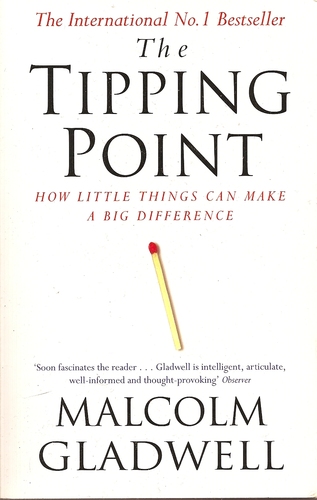The Tipping Point
The Tipping Point by Malcom Gladwell is about how little things in the right context can make a big difference in the success or failure of something such as a business, a television show, or getting a strong message across that influences people. The book is full of stories and statistics and may be a bit disorganized in that there is so much information thrown at the reader in each chapter. I have compiled an outline of key components of the book in the hopes that it may make the read less overwhelming. You can read them to get a gist for what the book is about. Then you may read the whole book if you like. You may or may not agree with Gladwell on his conclusions for what tipping points are in the examples he gives. Sometimes I find them hard to believe but fun to read nonetheless.

Three Rules of Epidemics
- Law of the Few – people who transmit infectious agents, a tiny percentage of people who are highly influential
- Stickiness Factor – the infectious agent that attracts those affected by the epidemic
- Power of Context – the environment in which the infectious agent is operating, people are more sensitive to their environment than they seem
These rules help us to understand teenage smoking, crime rates, phenomenon such as word of mouth, and the rise of a bestseller or popularity of a children’s TV show to name a few.
Hush Puppies
Hush Puppies is a shoe company that sells classic American brushed-suede shoes with light weight crepe sole. They went from selling to only un-hip people to a hugely successful national brand thanks to some New York trendsetters. A group of “opinion makers” start wearing Hush Puppies and others want to copy their style. Then a few fashion designers wore the shoes on the walkway and that’s where the tipping point was reached.
The Law of the Few
Connectors are people who are well connected to a large number of people in their community. They really know practically everyone, and are charismatic and influential like Paul Revere, who genuinely likes people. The importance of connectors can be pictured by the famous midnight ride of Paul Revere and William Dawes. Come again? Even though Dawes and Revere both rode out that night to practically the same number of places, Dawes was much less known and less people listened to him when he warned them of the British coming. Revere was highly influential, however, and his news spread like wildfire.
Mavens are people who accumulate a lot of knowledge and want to solve other people’s problems, generally by solving their own. They want to help people for the sake of helping people. It’s what they like to do. These people are effective in spreading epidemics as information about something new reaches them quickly and they pass it along to people around them. Their word is trustworthy. Revere was a maven and a connector.
Salesmen are persuasive speakers who love people. Their emotions rub off on the people around them. That is, they are so good at expressing emotions and feelings, they are emotionally contagious.
Stickiness Factor
Sesame Street
Each episode of Sesame Street was deliberately and painstakingly engineered with the children’s education in mind. Their show was built around the single breakthrough insight: that if you can hold the attention of children, you can educate them. They found that if children couldn’t make sense of what they were watching, would stop watching. Kids could multi-task, play with toys and watch at the same time and still have the same attention span and understanding of what they watched. They watch when they understand and look away when they are confused. Sesame Street tested their episodes before airing them, with kids, to measure their level of attentiveness. Then if something was wrong with parts of an episode where most kids lost interest, they would fix it. They also test to see if what kids pay attention to is what they should be paying attention to and whether or not they understand it. They use fovea tracking devices to see where kids look at on the screen so as to know how to place elements that are important in a way they can be seen and paid attention to. This was their way of dramatically enhancing stickiness. Although Sesame Street is painstakingly made and is sticky, it has limitations as the show was intended for children and their parents as well so that parents could watch and encourage their children, but this made it less sticky for the children as they don’t understand certain jokes and concepts. Another limitation is that each episode consists of about 40 segments each 3 or less minutes long. Children actually like the narrative form in storytelling better and are capable of this type of thinking even at age 2.
Blue’s Clues
Blue’s Clues builds on the notion that children’s television has too much talking and the audience is not that verbal. It’s important for a more visual form of storytelling rather than having many short scenes that are static. Todd Kessler believed kids didn’t have short attention spans and could easily sit still for half an hour. Each episode of Blue’s Clues was simple, with a few characters and a single storyline. The script has many instances of long pauses and no humor, cleverness or wordplay that Sesame Street had. Yet it is probably one of the stickiest T.V. shows ever made. Knowing that children like repetition in learning, Blue’s Clues ran each episode 5 times a week before going on to a new episode. Its target was preschoolers, who were driven by a search for understanding and predictability as they are surrounded by many things they don’t understand or know daily.
Yale Tetanus Advice Study
Students were put into two test groups that informed them to get tetanus shots at Yale University. In one group students were given a high-fear booklet that dramatically explained the dangers of tenanus as well as provided images of people who had tetanus. In the other group, the information was toned down and there were no images. As predicted, the people in the high-danger group were more convinced of the dangers of tetanus, but only 3% of the students overall actually got a shot. There was no stickiness factor. They did this study again with a map of the university with the hospital building circled, and the times the shots were available, and this small change made the total jump to 28%, and there was an equal number from the high-fear and low-fear groups. Even though the students were seniors and already knew the location of the hospital, this added information helped the students tie the information into their lives as a practical and personal piece of medical advice.
The Power of Context
New York City Crime
In the 1980s New York City had one of the worst crime epidemics in history. In 1990, there was a high, then crime rates declined rapidly. The tipping point did not occur because of the following factors: increased police presence, tougher sentencing, a good economy that lowered unemployment drastically among the underclass, those who commit crimes. The tipping point actually occurred because of a crackdown on graffiti on subway cars. Graffiti was cleaned off subway cars, and each time people tried putting graffiti on, it was cleaned. This showed the taggers that graffiti was not tolerated. Also, police cracked down on fare beating, stopping people from cheating, which gave them new moral values.
Magic Number 150
Groups of certain sizes and certain types can often be uniquely conductive to achieving the tipping point. Groups of less than 150 members usually display a level of intimacy, interdependency, and efficiency. Groups greater than 150 people tend to have less of that. A number of corporations that use this number as the foundation of their organizational structure succeed more in their business.
Rumors, Sneakers, Power of Translation
This chapter is about a case study of the rise and decline of Airwalk shoes. The brand originally only sold skateboarding shoes, but it wanted to transcend its niche market to attain national recognition. They succeeded with the help of an advertising agency that understood factors and variables that influence the public’s perception of “coolness”. The company had a unique strategy of offering unique products to boutique stores and a more mainstream shoe selection to department stores kept both hipsters and mainstream people happy. But later Airwalk made a cost-cutting move that provided all distributors with a single line of shoes. This made them less popular and sales declined significantly.
Suicide, Smoking, Stickiness and Unstickiness
There’s a relationship between a sudden rise in suicide among adolescent males in Micronesia and the persistent problem of teen smoking in the United States. Teens are inherently predisposed to imitate others and try new behaviors and attitudes during adolescence. The type of people who are more likely to engage in dramatic behavior such as smoking and suicide are more likely to emulate others. Suicide used to be unheard of in Micronesia, but it is now so commonplace that teens fail to see the seriousness of the practice. The failure of many anti-smoking campaigns has been that they focus on the cigarette. Most smokers know the risk of smoking, yet they continue. Smoking itself is not cool, but teens identify smoking with people who are cool. Both suicide and smoking are affected by people who are influential in the teens’ lives. Those people are identified as cool.
